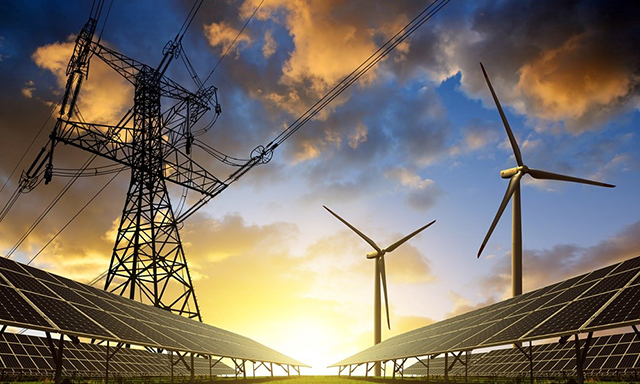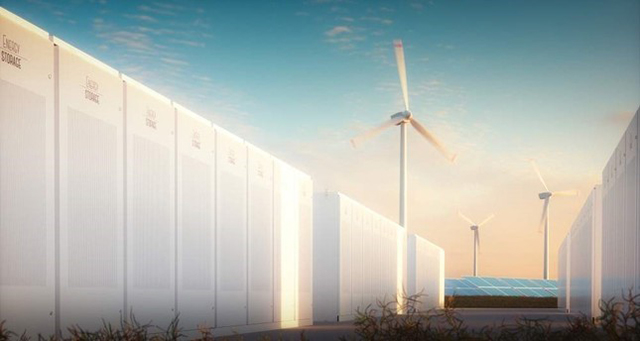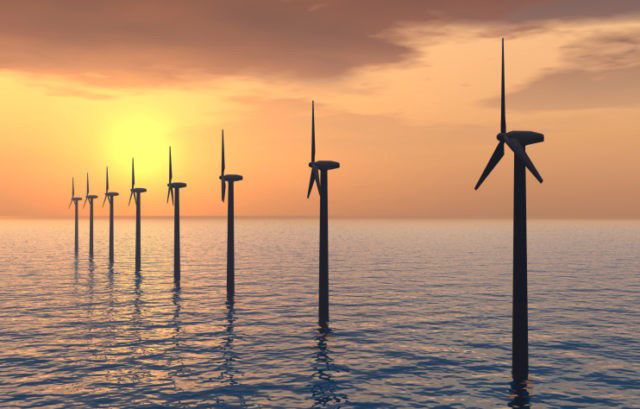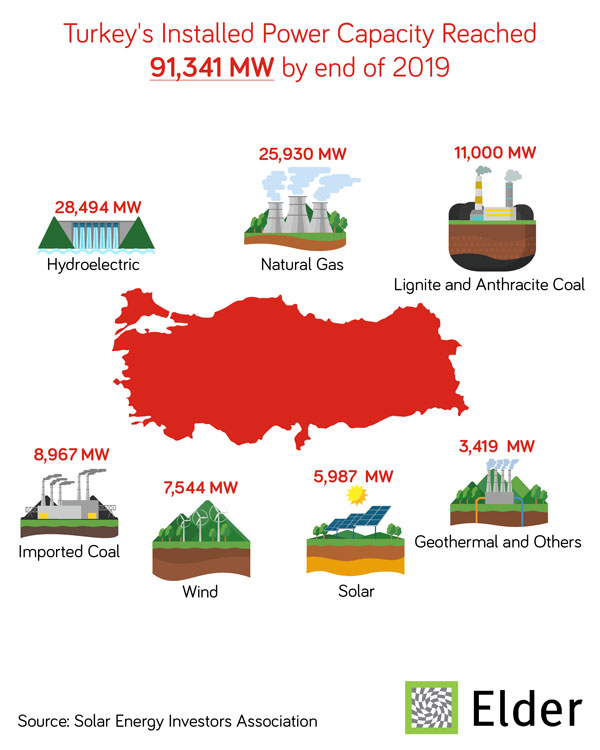
Turkey has made new annual renewable electricity and hydroelectricity generation records in 2019, according to the General Manager of Limak Holding - Energy Generation Group, Taner Ercomert, on Friday.
Ercomert, who is also the Executive Member of the Hydroelectric Power Plants Industry Businessmen Association (HESIAD), told Anadolu Agency that Turkey's annual electricity generation from renewable sources reached a new record volume of 132 billion kilowatt-hours (kWh) in 2019.
Hydroelectricity generation also hit a new annual generation record in 2019 with 88.641 billion kWh, he added.
Last year also saw daily and monthly hydroelectricity generation records realized on May 23 and May 2019 with 401.3 million kWh and 11.5 billion kWh, respectively.
According to Turkey's Solar Energy Investors Association (GUYAD), Turkey generated around 44% of its electricity from renewable resources last year; detailed as 29.47% from hydropower, 7.13% from wind, 3.18% from solar energy, 2.74% from geothermal energy and 1.34% from biomass and others.
In 2018, this generation breakdown was 19.66% for hydropower, 6.54% from wind, 2.56% from solar energy, 2.44% from geothermal energy and 1.19% from biomass and others.
Source: AA

Taiwanese energy storage and solar systems manufacturer United Renewable Energy (URE) aims to supply Turkey with systems to store electricity from wind and solar power plants, the 10-year electricity purchase guarantee of which will expire this year.
Chienping Hsieh, URE vice chairman of global sales and sales management, said it was compulsory in the past for electricity distribution companies to buy the energy from such plants whether they were able to sell it or not in a statement on Thursday to told Enerji Gunlugu, a Turkey-based online energy news platform.
“But these companies will no longer have an obligation,” Hsieh said, noting the wind and solar power plants produce electricity at certain times of day, thus this energy will have to be stored.
“In other words, new storage units will be needed,” he said.
Many of those power plants were supplied with a purchase and price guarantee for certain years, and they will be excluded from the scope of the Renewable Energy Support Scheme (YEKDEM) at the end of 2020 as they would complete the guaranteed time. Turkey currently has feed-in-tariffs for renewable energy power plants under YEKDEM. Although this system has been very useful in incresing Turkey's renewable capacity, the sector represenatives are now waiting for the introduction of a new program. Turkey currently enjoys 7,615 megawatts (MW) in wind power and has surpassed 6,200 MW in installed solar capacity.
Hsieh highlighted that the energy-storing systems they offer would be crucial for Turkey especially when the country aims to rely more on renewable energy. He said for the introduction of their systems to Turkish markets, the URE may either work with new service companies that are involved in the energy storage systems, or they can make agreements with wholesale companies.
Speaking further on URE’s energy storage products, Hsieh highlighted that the company’s products are different from many other products on the market, especially in terms of their batteries.
“The batteries used are, in fact, similar to phone batteries. Typically, LCM batteries are produced. But unlike our competitors, we use Lithium iron phosphate batteries. They are lower in energy density and much, much safer than cellphone batteries and other LCM batteries,” Hsieh said, noting many fire incidents in energy storage systems were related to LCM batteries.
Speaking of uninterruptible power supplies (UPS) still being widely used, Hsieh said factories use lead-acid batteries, and “people are turning to these batteries because they are cheap.” However, those kinds of batteries are forbidden from being purchased in Europe due to the heavy metal content in them, he added.
He said companies are more likely to prefer green batteries now to avoid dangerous outcomes.
Evaluating the current trends in Turkey, Hsieh said it is also a good time for offering the Turkish market such products as there were only large-scale tenders previously, but now small systems in residential buildings and rooftops are becoming more common.
URE employs 3,000 employees and is mainly active in producing solar cells, solar panels, solar systems and energy storage solutions.
Source: Daily Sabah

Berg Insight has released a new report analysing the global penetration of smart street lights between 2018 and 2023. The number of installed smart street lights will increase by 24.5% during the forecast period from 10.4 million to 31.2 million, according to the study. Europe is expected to dominate the market, with a 40% share of the industry, during the forecasted period.
North America had a 30% share of the market in 2018 owing to an increase in rollouts by utilities. Despite scattered deployment, the region is home to several of the world’s largest deployments. Levi Ostling, an IoT analyst with Berg Insight, said: “While various proprietary RF mesh or star networks today account for the majority of smart street lighting installations, the adoption of LPWA technologies such as NB-IoT and LoRa is now growing fast, particularly in the European and Asian markets.
“… the smart street lighting market is currently undergoing significant transformation and is now entering a new era of competition where the success of vendors will be determined by their ability to establish themselves as competitive providers of communications and management platforms for smart city devices.
“Finding new ways to monetise data from a variety of smart city sensors and devices will be essential for smart street lighting vendors in the next couple of years to avoid becoming mere vendors of commoditised hardware.”
Source: Smart Energy International

Siemens Gamesa is poised to grab the biggest turbine deal in US offshore wind to date after being lined up to supply the 2.6GW Dominion Energy Virginia Offshore Wind project.
The Spanish-German OEM was named preferred supplier to the project with turbines of a model and power yet to be finalised.
The Dominion project is by some distance the largest yet planned in US waters – and at a cost of $7.8bn the most expensive.
Markus Tacke, Siemens Gamesa CEO, said: “Signing this preferred supplier agreement with Dominion Energy attests to the enormously exciting growth taking place in the US offshore wind industry and across the globe.”
Completion of installation is seen by the end of 2026. The deal – which includes a long-term service agreement – is subject to a final investment decision by the Virginia utility and various approvals.
Dominion told Recharge in November it was mulling turbines between 8MW and 12MW for deployment at the project, which is expected to power 650,000 homes.
Gunnar Herzig, managing director of industry advocacy group World Forum Offshore Wind told Recharge: “This record-breaking agreement again underlines the enormous potential of the dynamically growing US offshore wind market. We expect to see more announcements of this calibre from the US East and West coasts over the next months and years.”
The preferred supplier deal is the latest – and largest – round in a three-way battle for the ever-larger projects seen in US offshore wind between turbine heavyweights Siemens Gamesa, MHI Vestas and GE Renewable Energy.
GE in September won a preferred supplier deal from Orsted to supply 12MW Haliade-X turbines for the 1.1GW Ocean Wind off New Jersey and 120MW Skipjack array facing Delaware.
In July, Siemens Gamesa scored a market breakthrough with 1.71GW of conditional orders from Orsted and its joint-venture partner Eversource for three projects: 880MW Sunrise Wind, 700MW Revolution Wind and the 130 South Fork array – all to be built in a zone off Rhode Island and Massachusetts.
Vineyard Wind earlier tapped MHI Vestas to supply 84 V164-9.5 turbines for its high-profile 800MW project, the nation’s first at utility-scale.
The Virginia preferred supplier deal builds on the 12MW Coastal Virginia Offshore Wind pilot, which Dominion is currently building with two Siemens Gamesa 6MW units.
Globally, the latest preferred supplier deal is second only to the 3.6GW megadeal secured by GE Renewable Energy for the Dogger Bank project in in the UK.
That means that while the US group triumphed in the waters off eastern England – home to Siemens Gamesa's Hull offshore wind factory – the European player has now prevailed in GE's American backyard.
Source: Recharge News

JinkoSolar Holding Co., Ltd. (the “Company,” or “JinkoSolar”) (NYSE: JKS), one of the largest and most innovative solar module manufacturers in the world, today announced that the Company has signed an MOU with Shanghai Institute of Space Power-Sources (SISP) to co-develop high efficiency solar cell technology for both space and terrestrial applications.
Innovators and engineers from both sides will co-develop space-based photovoltaic cells with a more efficient, low-cost, robust silicon wafer as the supporting bottom substrate and bottom cell.
This high-efficiency solar technology takes advantage of inexpensive silicon wafers. It is easy to manufacture at large scale and can achieve a higher conversion rate.
It has a more robust and rugged design, much lower degradation required for next-generation solar cells in space. Due to its unprecedented efficiencies, it could also be used in other applications like auxiliary power units in vehicles, solar roof tiles, power plants, and smart grid systems. This is an early-stage technology requiring additional development.
This partnership between two elite solar companies will fuel much needed development. This cooperation will not only set a good example of photovoltaic technology space application, but it will also bring new opportunities for Chinese photovoltaic industry to grow and develop abroad.
Dr. Jin Hao, Vice President of JinkoSolar commented, “The strategic cooperation with Shanghai Institute of Space Power-Sources has a great importance. In the future, we will continue to increase technical cooperation, leading our industry in the name of technical innovation and providing more efficient solar panels with a wider range of choices for global customers.”
Source: Associated Press

The US is the reference case in its newly published International Energy Outlook 2019 (IEO2019). The Administration of Energy Information (EIA) plans to increase world energy demand by almost 50% between 2018 and 2050. The majority of this growth comes from non-OECD countries and this development is centered on those areas where strong economic growth drives demand, particularly in Asia.
IEO2019 of the EIA analyses long-term global energy markets for 16 OECD and non-OECD regions around the world. IEO2019 is estimated in line with the 2019 Annual Energy Outlook in the United States.
The industrial sector, which comprises refining, mining, manufacturing, agriculture, and construction, represents the largest share of energy consumption of any end-use sector — over half of the energy use consumed over the projected period.
The energy consumption of transport between 2018 and 2050 rose by almost 40 percent. The growth of energy consumption in transportation between 2018 and 2050 rises by almost 80 percent, largely in non-OECD countries. For both personal and freight transport, energy consumption is growing significantly more rapidly in these countries than in many OECD countries.
Energy consumed in the construction industry, which comprises both residential and business buildings, grew by 65 percent from 91 to 139 quadrillion Btu between 2018 and 2050. Increased revenues, urbanization and access to electricity contribute to increased energy demand.
Renewables – including solar, wind and hydropower – are the fastest-growing source of energy between2018 and 2050 with the rapid growth in electricity generation and overcoming petroleum and other fluid as the most commonly used source for energy in the Reference case.
The global use of natural gas rises more than 40% between 2018 and 2050, hitting almost 200 quadrillions Btu by 2050. In the industrial sector, natural gas use rises as well as the natural gas used in the generation of electricity.
Consumption of liquid fuels over 20% rises between 2018 and 2050, while overall consumption in 2050 amounts to more than Btu 240 million. Demand remains fairly constant in the OECD countries throughout the forecast period, although non-OECD demand increases by about 45%.
Source: Alternative Energy 24
Demand-Side Flexibility for Power Sector Transformation
Power systems need to be increasingly flexible to accommodate rising solar and wind shares. One way to achieve this is by adjusting the demand for electricity to better match generation from solar and wind energy over the course of each hour, day, week or longer timeframe. This brief from the International Renewable Energy Agency (IRENA) maps out uses, solutions and examples of demand-side flexibility involving different maturity levels and different timescale impacts.
Please click here to read the full report.
Solar Istanbul 2020
March 11 - 13 / Istanbul
3rd International Forum Energy for Smart Mobility
March 31 - April 01 / Marseille
InnoGrid2020+ Conference
May 05 - 06 / Brussels
23rd World Hydrogen Energy Conference
July 05 - 09 / Istanbul
4th International Conference on Energy Research and Technology
August 19 - 21 / Praque

